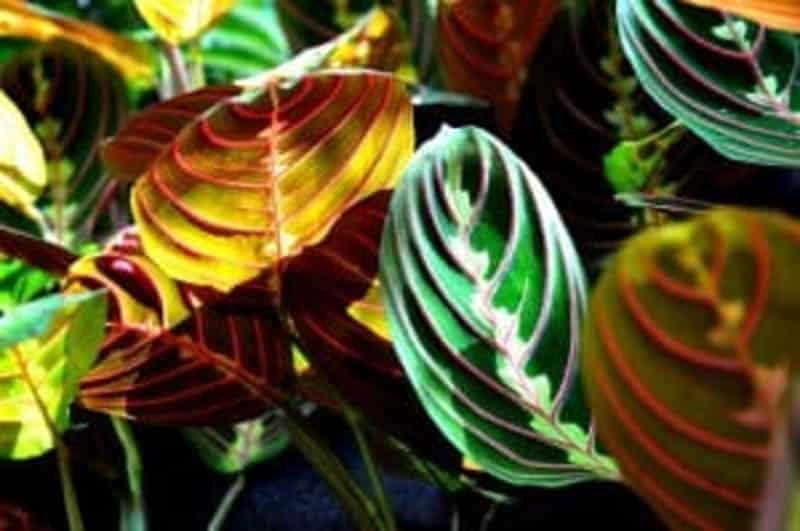I am sure you have seen the pictures. Maybe your mom had one, or your grandmother. I know mine did. Colorful, interesting patterns on the leaves, easy to grow and propagate. And, they look like they are praying. Who wouldn’t want one? Here, I’ll tell you everything you need to know about the Maranta Leuconeura as well as the other varieties of Maranta so you can make an educated decision on which is right for your space.
Let’s Talk About Marantas – Prayer Plants
Marantas are hardy houseplants that can take a lot of abuse. That’s what makes them such popular houseplants. They are a slow, low-growing spreading plant that goes well in low pots, tall pots, or hanging baskets. They will spill out over the edge of the container creating a nice presentation on a table, a sideboard, or hanging in a corner. They are hardy in low, medium, or bright light making them even easier to care for.
Most of the varieties come with variegated leaves, which makes it even more interesting to look at. The underside of the leaves varies from grey-green to purple-green. They bloom in the spring with tiny white or purple flowers that look a bit like snapdragons.
Why is it called a Prayer Plant? Why, because of its leave of course. At night the leaves fold together giving it the appearance that it is saying its prayers before bed.
Caring for You Marantas
These lovely plants will thrive in any light though they do need a little protection from direct sun. If in front of a window that gets direct sun, make sure it is protected by a sheer curtain. Water it as needed. This guy likes to stay moist, but not drowning. Water lightly as it just as the soil starts to feel dry. If its leaves start to brown, it getting to dry or has been dry to often. Make sure it’s soil and pot is well drained.
Indoor plant fertilizer once or twice a year is plenty. Any fertilizer made for indoor plants should be fine, just make sure you follow the directions on the package. This plant prefers above-average humidity but usually does fine in most homes. If your winters are too dry and your plant seems sad, boost the humidity levels around the plant to make it happy.
There are two ways to propagate. You can dig the plant up and separate the roots in the early spring replanting into multiple pots. Make sure you transplant them into well-draining soil and keep them moist until they start to establish themselves in their new home.
You can also propagate from cuttings. Take a stem cutting just below the nodes towards the bottom of the stem. You can keep this cutting in water, adding a rooting hormone if desired. I have read mixed information on the rooting hormone but have never had a problem starting them without.
Once you have sufficient roots, you can plant the baby into the soil, being mindful that it is well-draining soil in a pot that will not contain water. Remember, no soggy roots.
To prune for fuller growth, use sterilized gardening shears so you don’t spread disease from other plants. Trim the stem just above the leaf node where new shoots will grow directly below this cut area. It is recommended that pruning happens a couple times per year, in the fall and again in the spring just before the growing season starts.
Varieties of Maranta Plants
The Maranta Plant family has over 530 species that live in the Tropics of Central and South America. However, here I will tell you a little about 10 popular varieties that you can grow in your home.
Maranta Arundinacea: A new variety also known as Arrowroot.
- Can grow 3 – 6 feet tall with an upright stem and sword-shaped leaves.
- Light green leaves with white splotches.
- Likes brighter lighting than the green varieties and temperatures over 70⁰
- If conditions are right, it will produce small white flowers in clusters.
- This variety has a fleshy underground rhizome, so be careful about over-watering.
Maranta Cristata: Also known as Maranta Bicolor
- Small leaves with a silver oak-leaf-shaped patch along the center rib with dark green spots along the outside of the silver. The rest of the leaf is green.
- New leaves are lime green.
- Prefers medium indirect light
- Do not use harsh fertilizers.
- Grows up to 12 inches tall and 3 feet wide.
Maranta Leuconeura: This is a complicated variety with three varieties that each contain multiple varieties
- Erythroneaura
- Red Maranta
- large oval-shaped leaves with bright red fishbone-shaped veining.
- Lime green zig-zag stripe down the middle of each leaf.
- Likes bright indirect light and moist soil.
- Lemon Lime
- A subspecies of the Red Maranta.
- Colors: light green with dark green splotches on both sides of the center rib.
- Can live in a hanging basket.
- 12″ tall and 3′ wide.
- Can lose its vibrant colors in low light.
- Red Maranta
- Kerchoveana
- Green Maranta: the most common variety in Maranta House Plants.
- Light green with dark splotches.
- Can hang or sit on a surface.
- Can lose their color in low light.
- 12″ tall and 3′ wide.
- Kerchoveana Variegata: Beauty Kim.
- Green with cream-colored splotches with reddish-purple variations in the younger plants.
- Dark green splotches along the center rib.
- High humidity but keep leaves dry.
- Keep away from direct sunlight
- Massangeana:
- Black Maranta
- Not widely available but can be found online.
- leaves with silver veins, pale green center rib, the outer edge of the leaf is such a dark green it’s almost black.
- Silver Band Massagneana
- Silver and dark green markings with a “black” halo surrounding them.
- Delicate: only used diluted fertilizers and distilled water.
- Can be exposed to bright indirect light without fading.
- Cat Mustache Massengeana: Newly identified.
- Combination of the Black Maranta and the Silver Band Maranta.
- Black markings become more distinct in brighter light.
- Black Maranta
And Now What?
See, that’s everything you need to know to make an educated decision. They are a great addition to any plant area in your home or even at the office if it’s kept at a regulated temperature and not left to the cold at night. It brightens up a space, helps keep the air clean, and can make a nice conversation with people, especially with its nightly praying leaves.
The one I have is a green Maranta and has been sitting on that table for about 5 years and hasn’t grown much, so like I said above, they grow slow and steady, are easy to care for, and thrive in even my home of too many animals, good indirect light, and warm and cold weather. So, pick one up and enjoy it!
If you would like to check out some of my other gardening articles check out my Modern Homesteading Series (published on Wednesdays) as well as my Creative Gardening By the Moon (published on Sundays). There are also many other gardening articles to by found on Total Apex Entertainment. We would love to see you there.
About The Author
A late bloomer in the writing industry, Christle Hart has just joined the world of writing as a published Author, poet, and content writer. As a teacher for 20 years, she has made a smooth transition from teaching writing to publishing her own work and is excited to be doing so. You can even check out her first novel which has finally been released.
Check back here for more of her articles focused on gardening, cooking, horoscopes, movies and TV, gaming and so many other passions. You can find her on her website where her blog, The Nook, is also located. You can also find her on Facebook.
For More Great Content
Total Apex is an all-encompassing content producer. We provide heavily detailed articles every day on entertainment, gaming, sports, and so much more! Check out all our great sports content at Total Apex Sports. Check us out on X @TotalApexEandG and our other sites: Total Apex Sports Bets and Total Apex Fantasy Sports.





